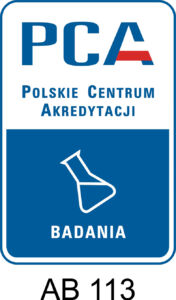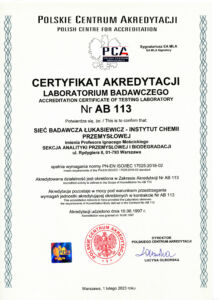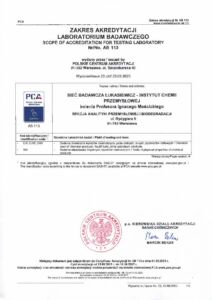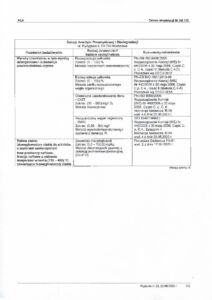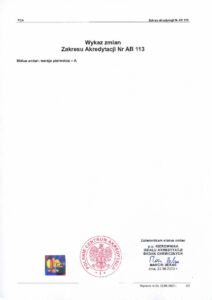Sustainable Chemistry Center
Chemical Technology RESEARCH GROUP
Area Leader
Antoni Migdał, PhD. Sc. Eng.
phone +48 517 883 146
antoni.migdal@ichp.lukasiewicz.gov.pl
Secretariat
Anna Bilińska
phone +48 517 883 147
anna.bilinska@ichp.lukasiewicz.gov.pl
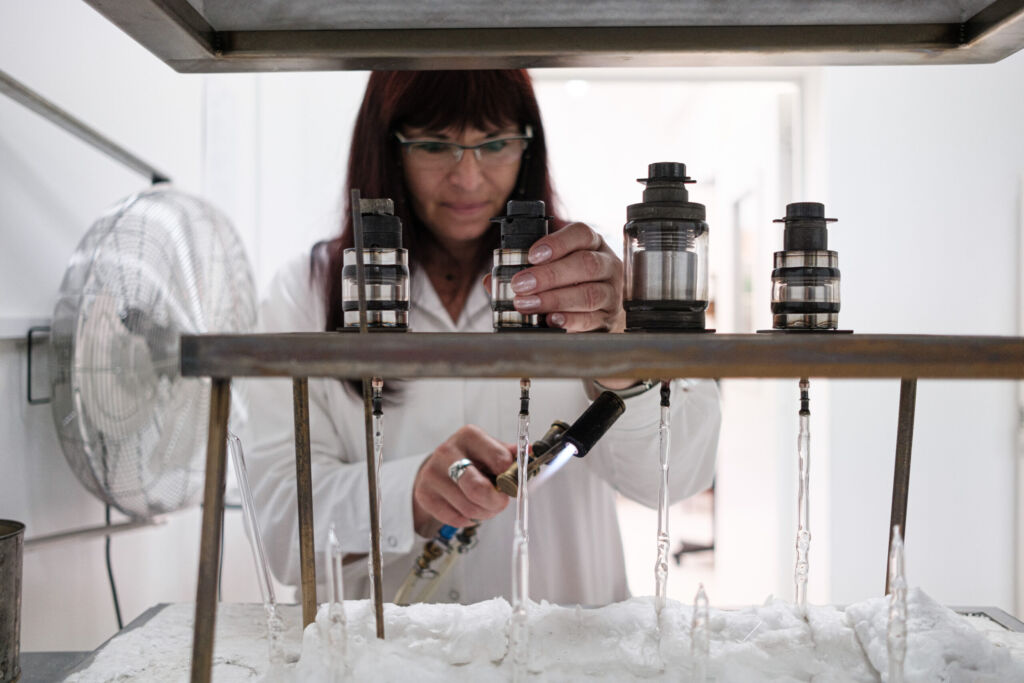
Head
Dr. Robert Brzozowski Eng.
phone +48 517 883 148
rober.brzozowski@ichp.lukasiewicz.gov.pl
Research topics
- Processes of the great organic synthesis →
- High-pressure processes →
- Identification analysis of organic compounds →
- Research and design offer →
- Synthesis of ionic liquids →
- Highly processed chemicals – biocides and hygienizers →
- Bioprocesy w technologii chemicznej →
- Separation of azeotropic mixtures →
- Fuel desulphurisation process →
- Analysis of organic compounds →
Head
Magdalena Litwinowicz, PhD. Sc. Eng.
phone +48 516 109 996
magdalena.litwinowicz@ichp.lukasiewicz.gov.pl
Research topics
- Studies on dehydrogenation processes of light aliphatic hydrocarbons (C3, C4)
- Studies of catalytic processes in multiphase systems under elevated pressure and temperature conditions; laboratory and semi-technical scale
- Production of synthetic fuels – Fischer-Tropsch synthesis using CO2
- Process development, design and optimisation – environmentally friendly alternative synthesis routes (laboratory to large-scale)
- Treatment of gaseous/liquid product streams
- Separation of process streams by membrane techniques.
Experience
- Industrial catalyst testing
- Thermal conversion processes (pyrolysis, cracking)
- Dehydrogenation of low molecular weight olefins
- Calculation, design and optimisation of chemical apparatus and processes
- Separation of process streams by membrane techniques
- Fischer-Tropsch synthesis.
Research methodology and equipment
- Large-scale laboratory-scale installation designed to test the low-pressure dehydrogenation of hydrocarbons
- A modular distributed control system – the iFIX industrial automation system – used to operate the above installations
- Large-scale laboratory installation for testing the Fischer-Tropsch process
- Large-scale laboratory plant for the study of thermal processes (pyrolysis, cracking)
- RGA analyser – ARNEL Clarus 690 gas chromatograph with FID and TCD detectors;
- Laboratory pressure vessel, equipped with fixed bed reactors (100 ml capacity)
- Membrane test bench for gas purification and separation processes
- Pervaporation test bench for purification and separation processes
- ChemCad 8.3 software
Head
Antoni Migdał, PhD Sc. Eng.
phone +48 517 883 146
antoni.migdal@ichp.lukasiewicz.gov.pl
Research topics
- Expertises and assessments of prospective developments in chemical and petro-refinery processes
- Mechanochemical support and other methods for the intensification of industrial organic syntheses
- System solutions for oleochemistry, cascade processing of waste, forest and agricultural biomass and renewable raw materials
- Evaluations of technological concepts in the context of industrial implementation – including raw material and process integration
- Optimisation and up-scaling of petro-, biorefinery and recycling processes (following concept evaluation)
- Pyrolysis, cracking and gasification processes for waste plastics and rubber, biomass and unsorted municipal waste
- Biorefinery methods for the production of base chemicals, highly processed compounds and propellants (2nd and 3rd generation biofuels)
- Hydrogen production technologies for the chemical industry, distributed energy and electromobility
- Design, preparation and characterisation of catalysts for organic syntheses
- Enantioselective catalysts in organic synthesis processes
- Mineral and plant-derived fillers for polymer composites and refinement of recyclates
- Physicochemical analyses of catalysts, process streams and products of petro-, biorefinery and recycling processes.
Experience
- Expertise in chemical and petro- and biorefinery process development directions;
- Mechanochemical intensification of industrial chemical processes;
- Development of new, technologically attractive pathways for waste management and biomass processing, including for propellants and highly-processed compounds;
- Production of highly processed compounds from renewable raw materials (e.g. chlorophyll-based);
- Development of new, efficient catalytic systems;
- Scaling up technological processes.
Technologies developed
- Technology for the production of second generation bio-carbons (from waste animal oils and fats)
- Technology for low-pressure hydrogenation of olefins with methanol (commercialised)
- Technology for the oxidation of acrolein to acrylic acid
- Technology for the dehydration of glycerine to acrolein
- Technology for the esterification of acrylic acid with ethanol
- Technology for the esterification of acrylic acid with ethanol
- Technology for the esterification of acrylic acid with 2-ethylhexyl alcohol
- Ash oil processing technology
- Technology for producing glycerine ether derivatives
- Technology for the sonochemically assisted synthesis of diacetone alcohol (commercialised)
- Technology for the extraction and transmetallation of chlorophyll
Analytical methodology
Characteristics of solid materials:
Physico-chemical analysis of solids and catalysts: BET, TPR, TPO, TPD, porosimetry
Characterisation of products and streams of petro-biorafinery and recycling processes:
- determination of formaldehyde content (in cosmetics) by HPLC method in accordance with the Regulation of the Minister of Health of 16.07.2004 (Journal of Laws No. 206 item 2106 of 22.09.2004)
- determination of free and total glycerol and mono-, di- and triglycerols according to EN 14105 of February 2004 Oil and fat processing products. Fatty acid methyl esters (FAME).
- determination of free glycerol content according to EN 14106 of 2004. Oil and fat processing products. Fatty acid methyl esters (FAME).
- determination of methanol content according to EN14110 of 2004. Oil and fat processing products. Fatty acid methyl esters (FAME).
- determination of water by Karl Fischer coulometric titration according to EN ISO 12937 of 2003. Petroleum products.
- determination of viscosity of fats, raw materials and cosmetic products using Brookfield rotational viscometer according to IPC procedure No NB 12/5/97
- determination of density or relative density by the areometer method according to PN-ISO 3675, May 1997 Crude oil and liquid petroleum products.
- determination of iodine number according to EN 14111 of 2004. Oil and fat processing products. Fatty acid methyl esters (FAME).
- determination of iodine number according to PN-ISO 3961 of 1998. Vegetable and animal oils and fats.
- determination of acid value according to EN 14104 of February 2004. Oil and fat processing products. Fatty acid methyl esters (FAME).
- determination of acid value and acidity according to PN-ISO 660, 2004. Vegetable and animal oils and fats.
- copper plate test according to EN ISO2160, 2004, Petroleum products. Corrosive effects on copper.
- determination of impurities in middle distillates according to EN 12662 of 2003. Liquid petroleum products.
- qualitative GC-MS analysis with component identification based on the Wiley 9th Edition/NIST 2009 spectral library
- quantitative GC-MS analysis with component identification based on the Wiley 9th Edition/NIST 2009 spectral library
- analysis of the composition of process gases (CO, CO2, H2S, O2, H2)
- non-standard analyses, e.g. determination of optical rotation, pH measurement, electrical conductivity
Analytical equipment
- ChemBet 3000 TPR/ TPD /TPO Quantachrome Instruments thermal differential analysis and specific surface area measurement station with MS PRISMA PLUS detector (Pfeiffer)
- Micromeritics Tristar II 3010 for the determination of the specific surface area and porosimetry of solids
- gas chromatographs
- GC-MS Agilent Technologies GC 7890A MS 5975C inert XL EI/CI
- HP 5890-II PLUS GC-5989 MS Engine
- HP 6890 (GC-FID/AED)
- Shimadzu GC-2010 (GC-FID with AOC-20i autosampler)
- Shimadzu: 17A (GC-FID)
- chromatographs
- HPLC-MSShimadzu LC-2010 with SPD-M20A diode array and LCMS-2020 mass detectors,
- HPLC – Perkin Elmer; LC 250, detektor Diode ArrayDetector 235C, integrator 1020 LC PLUS, USA,
- Shimadzu 10 A, equipped with a UV-VIS spectrophotometric detector,
- Shimadzu LC-6A with detectors: UV, analytical with RF-10AXL luorescence detector and UV-VIS type DAD detector (SPD-M10AVP)
- MADUR GA 21-PLUS flue gas and emission analyser determination: O2, CO, CO2, CHx.
- Thomex Cubix-FRX-06 process gas analyser O2 (1-25%), CO, CO2 (NDIR measurements from 0-100%)
- VOC ppb RAE-3000 analyser,
- VIS-723 RAYLEIGH spectrophotometer
- Automatic Polarimeter AP 100 Atago
- pH meters: Metler-Toledo Sewen Easy, Toledo Delta 350
- conductivity kit CC-551
- Abbe RL3 refractometer
- Metrohm’s 701KF-Titrino and 703Ti-Stand apparatus with reagents for the determination of water in the presence of aldehydes and ketones
- kulometr DL39, Karl-Fisher Metler Toledo
- muffle furnace PK-6/1350 with accessories
Research equipment
- Bandelin Sonopuls HD 2070 ultrasonic homogeniser
- ultrasonic reactors: ELAC Nautik (URS 1000) Intersonic (IS-1K, flow-through system, bioreactor test bench interfacing with ROTH “0” and “I” autoclave), Ultron for homogenisation of systems and mechanochemical support of catalytic processes
- microwave reactors from Ertec (Magnum 02-04, prototype 6kW flow system), Plasmatronics (RM1000), CEM (Discover II with Coolmate attachment and fibre optic camera) for substance mineralisation and mechanochemical support of catalytic processes
- Christ LMC-1 Gamma 2-20 freeze-dryer with FOC-1K50 bath
- Julabo cryostats FLW4003, F33ME, F32ME, FP50, CF40,
- Julabo thermostats SL6,SL10
- water baths, glycol baths, oil baths
- Laboratory centrifuge MPW-340
- press (pasting machine)
- laboratory ketene generator
- large-scale second-generation biofuel plant
- fractional oxidation flow plant
- fractional flow alcohol dehydration plant
- fractional flow esterification plants with azeotropic product recovery
Contact persons responsible
PhD. Sc. Eng. Antoni Migdał – supporting and scaling up petro-refinery and recycling processes
phone +48 517 883 146
antoni.migdal@ichp.lukasiewicz.gov.pl
PhD. Sc. Eng. Osazuwa Osawaru – catalytic petro-refinery processes
phone +48 517 883 163
osazuwa.osawaru@ichp.lukasiewicz.gov.pl
Head
Dominika Kubica, PhD. Sc. Eng.
phone +48 517 883 165
dominika.kubica@ichp.lukasiewicz.gov.pl
Evaluation and analysis of household chemical products and raw materials:
Laundry detergents: evaluation of washing performance under real conditions, testing of washing capacity, encrustation, decrease in tear strength, greying, yellowing, shrinkage, discolouration, maintenance of whiteness, softening of washed products.
- Liquid dishwashing detergents: test of washing capacity (IKW test, direct washing test) test of fat emulsifying capacity.
- Sanitary cleaners: test of limescale-dissolving capacity.
- Cleansing milks and powders: testing of washing capacity and surface damage.
- Glass cleaners: testing of dirt-removing capacity, dry matter, alcohol content.
- Shampoos: testing of foaming capacity.
- Analytical and physico-chemical testing of raw materials and finished products.
Shampoos: testing of foaming capacity.
- Wet Abrasion Scrub Tester 903/PG, SheenInstruments Ltd
- DataColor 400 spectrophotometer
- Komora True View 2 DataColor
- Micro-TRI-gloss meter, BYK-gardner
- Soxtec System 2 HT2 kits, Tecator
- Muffle furnace 48000, Thermolyne
- Testing machine LRX, Lloyd
- Equipment to evaluate the washing ability of hand dishwashing detergents
- Rotary-oscillation washer
- Dishwashers, Siemens
- Foaming capacity and foam persistence index evaluation equipment
- Equipment for assessing descaling capacity
- RVF viscometer, Brookfield
- Mettler Toledo PM400 vagranspirator
Contact
Eng. Renata Dudek
phone +48 517 883 166
renata.dudek@ichp.lukasiewicz.gov.pl
Tests for ultimate biodegradation of organic compounds including detergents
- Tests for ultimate biodegradation by manometric respirometry
- Investigations on ultimate biodegradation by measurement of dissolved organic carbon loss (DOC)
- Determination of chemical oxygen consumption (COD)
- Determination of dissolved organic carbon (DOC)
Tests performed by methods according to Commission Regulation (EC) No 440/2008 of 30 May 2008, OECD 301 and the standards PN-EN ISO 9408:2005, PN-EN ISO 7827:2013-06, PN-ISO 6060:2006 and ISO 8245:1999(E).
The laboratory is notified in the countries of the European Union for testing the biodegradation of detergents in accordance with Regulation No. 648/2004 EC of the European Parliament and of the Council of 31 March 2004 on detergents (Official Journal of The European Union 2009/C39/05).
Shampoos: testing of foaming capacity.
- Closed-circuit respirometer Sapromat E, Labortechnik H+P
- Automatic carbon analyser TOC-5050, Shimadzu
- BigBigger Bill shakers, Brunswick, USA
- Equipment for the determination of COD by the titration method
Contact
Eng. Renata Dudek
phone +48 517 883 166
renata.dudek@ichp.lukasiewicz.gov.pl
Determination of triacylglycerols
Determination of triacylglycerols by gas chromatography in biocarbons and petroleum fractions containing biocarbons (accredited method).
Research equipment
Gas chromatograph 5890 Series II
Contact
Dominika Kubica, PhD. Sc. Eng.
phone +48 517 883 165
dominika.kubica@ichp.lukasiewicz.gov.pl
Małgorzata Walkiewicz, M. Sc.
phone +48 517 883 168
malgorzata.walkiewicz@ichp.lukasiewicz.gov.pl
Analysis of organic compounds, polymers and plastics
- identification of organic compounds, polymers, plastics, paints, glues, binders, etc. by spectrophotometric and chromatographic methods;
- identification and structure studies of non-volatile organic substances, e.g. synthetic and natural polymers, biochemical and geochemical products using the Py/GC/FTIR method;
- determination of average molecular weights and molecular weight distribution of polymers by gel permeation chromatography (GPC);
- analytical studies of organic compounds using FTIR and UV-VIS absorption spectrophotometry methods;
- studies of the curing and cross-linking of macromolecular compounds using the FTIR method (determination of functional groups);
- compositional analysis (identification of volatile components) of mixtures of organic compounds using GC/MS and GC/AED methods;
- determination of trace amounts of toxic substances (monomers and solvents) in plastic and other products by GC method using head-space technique, flame ionization detectors (GC/FID) and atomic emission detectors (GC/AED) and electron capture detectors (GC/ECD);
- determination of C1–C3 alcohol content in household chemical products and pharmaceutical products using the GC/FID method;
- determination of the content of organic acids, hydrocarbons, alcohols, esters and ketones in gas samples by GC/FID;
- testing the migration into food simulants and the emission of trace amounts of substances from plastic products into the atmosphere using spectrophotometric and chromatographic methods;
- control of the purity of chemical raw materials and testing of technological processes using UV, GC, FTIR and AAS methods.
Contact
Joanna Sołtysiak, PhD Sc.
phone +48 517 883 167
joanna.soltysiak@ichp.lukasiewicz.gov.pl
- determination of volatile fragrance and aroma compounds by GC-MS;
- determination of organic compounds in cosmetic raw materials by gas chromatography (GC-MS, GC-FID);
- identification of volatile organic compounds in various matrices by GC-MS and Headspace-GC-MS;
- determination of the fatty acid composition in vegetable oils and animal fats (in accordance with PN-EN ISO 5508:1996 and PN-EN ISO 5509:2001) by the GC method;
- analysis of gas samples using GC-MS and GC-FID/TCD methods
- determination of formaldehyde content in cosmetic products and raw materials (in accordance with the Regulation of the Minister of Health of 16 July 2004, Journal of Laws No. 206 of 22 September 2004, item 2106) using the HPLC method;
- determination of water content by Karl Fischer coulometric titration according to PN-EN ISO 12937 and ASTMD 6304
- determination of water content by Karl Fischer potentiometric titration
- determination of bromine index by coulometric titration according to ASTMD1492
- determination of bromine number by coulometric titration
- determination of density – hydrometer method according to ASTMD 1298 and PN-EN ISO 3675
- determination of density – pycnometer method
- determination of phosphorus content by spectrophotometric method according to AOCS Official Method ca 12-55
- determination of free water content according to ASTMD 2709
- determination of the content of unsaponifiable substances in vegetable and animal oils and fats according to PNISO 3596
- marking of insoluble contaminants in vegetable and animal oils and fats according to PN-EN ISO 663
- determination of iodine value according to PN-EN 14111
- determination of the peroxide value in vegetable and animal oils and fats according to PN-EN ISO 3960
- determination of saponification value according to PN-C-04043
- determination of acid value according to PN-EN 14104 and PN-ISO 660
- determination of water content and volatile substances in vegetable and animal oils and fats according to PN-EN ISO 662
- aniline point determination according to ASTMD 611
- determination of asphaltene content according to ASTMD 3279
- determination of the flow temperature according to PN-EN ISO 3016
- determination of the refractive index according to ASTMD 1218
Contact
Dominika Kubica, PhD. Sc. Eng.
phone +48 517 883 165
dominika.kubica@ichp.lukasiewicz.gov.pl
Małgorzata Walkiewicz, M. Sc.
phone +48 517 883 168
malgorzata.walkiewicz@ichp.lukasiewicz.gov.pl
PCA Accreditation
Head
Katarzyna Skrzypczyńska, PhD. Sc. Eng.
phone +48 453 056 292
katarzyna.skrzypczynska@ichp.lukasiewicz.gov.pl
Research topics
- Hydrometallurgy and electrometallurgy of non-ferrous metals
- Recovery of metals and valuable elements from products and industrial wastes
- Technologies for obtaining nanometals for industrial applications
- Treatment of industrial and waste electrolytes from metallic impurities
- Application of new electrode materials in cells, batteries and supercapacitors
- Low-temperature polymer electrolyte fuel cells – cell construction and testing
- Research into electrocatalysis and the mechanism and kinetics of selected electrode processes
- Disposal and recycling of batteries and accumulators
- Polymer composites with metallic fillers
- Investigation of the properties and analysis of materials using modern physico-chemical methods (SEM, PCS)
- Determination of metal content in aqueous solutions and in organic, inorganic and mixed-matrix organic-inorganic samples (after dissolution/mineralisation of samples)
Experience
- Preparation of electrodes and conduct of electrode reactions relevant to electrochemical energy sources
- Construction and testing of batteries and cells
- Construction of efficient energy fuel cells of the DMFC and H2-PEFC types
- Construction and design of electrochemical test benches
- Investigations in the field of electrochemical processes of separation of metals and their compounds on various substrates (RVC®, GC, Pt, Au, Fe, Pb, PbO2, graphite, ultramicroelectrodes)
- Research in the field of purification of waste electrolytes from metallic impurities
- Development of a technology for obtaining copper powders and nanopowders
- Development of a method for obtaining polymer composites with copper nanopowders for use in shielding electromagnetic radiation
Research methodology and equipment
- electrochemical testing
- Potentiostat Volta,LAB PGZ 301, Radiometer Copenhagen
- Potentiostat/galvanostat Autolab PGSTAT30, FRA 2, Eco Chemie
- Potentiostat/galvanostat type SI1287, Solartron
- CHI 700C bipotentiostat with Pine rotating electrode
- Laboratory power supply AMREL LPS 303
- Laboratory power supply TTi EX354RD DUAL
- AXIOMET laboratory power supply AX-3020L
- CHI 440 Electrochemical Workstation potentiostat with Binder MKF 720 climate chamber
- Electrochemical quartz microbalance M-106
- Fuel cell test stations from Fuel CellTechnologis Inc. 1 kW and 150 W
- Programmable power source 1 kW, HP 6031 A
- Programmable current collector 300 W Agilent 6051A
- Kavalier flaker including PKM-300 pressure press
- examination of surface structure and morphology by scanning electron microscopy (SEM) and qualitative composition analysis by X-ray energy dispersive spectrometry (SEM/EDS)
- Scanning electron microscope (model JEOL JSM 6490LV) with X-ray energy dispersive microanalyser (EDS)
- determination of the metal content in aqueous solutions and in solid samples after dissolution (inorganic samples) or after mineralisation (organic samples and mixed organic-inorganic matrix samples)
- PerkinElmer AAnalyst 300 atomic absorption spectrometer
- PerkinElmer AAnalyst 800 atomic absorption spectrometer
- Milestone’s UltraWAVE microwave sample dissolution/mineralisation system
- Milestone DMA-80 mercury analyser
- Nabertherm muffle furnace L15/11/B170
- determination of particle size and zeta potential (PCS)
- ZETAMASTER S particle size analyser model DTS
